|
609 (West Riding) Squadron Royal Auxiliary Air Force. Based at RAF Leeming.
While collecting my latest purchase, a bread maker courteous of 'E Bay', and fumbling around to pay for my item and exchanging pleasantries between myself and the seller, a friendly Scot, the words plane spotter and aircraft fanatic somehow got in our conversation, "I wonder how' and the next thing you know my seller informs me that he is a member of 609 West Riding Squadron., based locally at nearby RAF Leeming. Knowing nothing about this squadron let alone anything about the Auxiliary Air Force I stopped and listened to learn some facts about the squadron, its history and a bit about the organization it came under.
I left our meeting with my next point of interest in my hobby, of all things aviation, keen to find out about 609 and why hadn't its number rang any bells for me but having just said this we can't lay claim to knowing everything there is to know about our chosen interest just because we stick our hands up to having an avid enthusiasm. Scratching the surface, doing some rough research, felt a bit like metal detecting standing a foot above a panzer tank, the deeds and names I was uncovering were beginning to form a who's who in air force history with the sound of hunting horns blowing, a part of the symbol on 609s badge along with Kenneth More uttering those immortal words from the film of 'The Battle Of Britain', 'Angels one five, Tally Ho'. This motto 'Tally Ho' was 609's motto, also proudly written on the scroll of the bottom of their unit badge, my ignorance of this famous squadron's past was now truly coming to light and so deserving to be told again, these are some of the facts, figures names and dates I came up with as a form of thank you to some of Britain's finest I could only dream of being as a child of in the 60s.
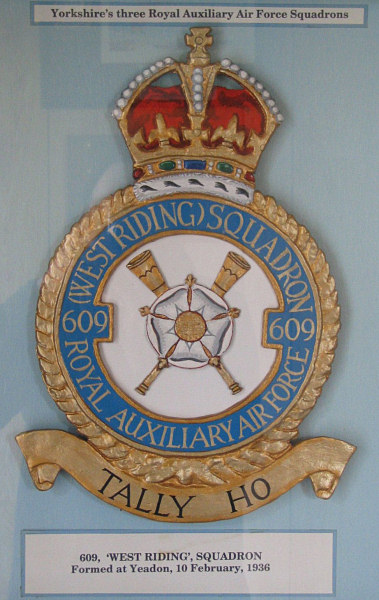
609 Sqn Badge
Photo - John Bilcliffe
Next I set about discovering when life began for 609wr squadron, forming on the 10th February 1936 at RAF Yeadon, now known now as Leeds/Bradford Airport, beginning as a bomber squadron flying Harts and Hinds with a Sqn/Ldr Harald Peake being granted a commission in the Auxiliary Air force to command the squadron and the honor of first amateur pilot being posted to the squadron going to Stephen G Beaumont, a junior partner in a firm of solicitors. Selection according to official records shows preference was shown to potential candidates who lived within a Ten mile radius of Leeds city center and any outside this had to have their own transport and all applying must be below the age of 38.On the 8th of December 1938 it was redesignated a fighter squadron and was in line as one out of nine squadrons to receive the Spitfire but didn't receive its first Mk1 until August 1939, some three years and four months later from the maiden flight of prototype K5054 lifting off from Eastleigh, Hampshire on the 5th of March 1936 in the hands of ,'Mutt ' Summers ,Vickers chief test pilot.
From Yeadon the squadron moved a little way up the road North to Catterick as part of 13 Group and were preparing for another move yet to Drem in Scotland via Acklington in Northumberland. It seems from their records 609 was a bit of a flying circus moving 21 times in all and revisiting some of the same camps for a second visit some five times, it was while at Drem the squadron claimed its first victory, a Heinkel He 111, shot down in February 1940 by Flying Officers Ayre, Persse-Joynt and Pilot Officer Buchanan.
The Drem lighting system was invented at this airfield in 1940 by the then C/O 'Batch' Atcherly, who understood the difficulties of aircraft such as the spitfire and hurricane having poor visual problems on approach from having long noses and the glare from the exhausts especially at night making it difficult to land so he set about designing two circles of lights set up at certain angles and heights and crossing these in the middle with two sets of lights running parallel either side of the runway with a funnel type shape at either ends of this making a shape similar to that of a bridge symbol used on ordanance survey maps, then placing a red light at one end of the strip with a white at the other to indicate the active end, this system used in conjunction with specially adapted baffles fitted to the aircrafts exhaust to reduce glare helping pilots especially at night to land more safely.
After Scotland, the squadron moved down to RAF Northholt in May 1940 where it assisted in the evacuation of Dunkirk and then moving again two months later to Middle Wallop in July 1940 taking part in perhaps the RAF's most famous moment during WW2, the 'Battle of Britain', where 609 became the first squadron to reach 100 hundred victories with the shooting down of a Junkers Ju 88 strafing Old Sarum on the 21st of October 1940 with the honor going to Flt/Lt frank Howell and P/O Sydney Hill, its worth mentioning that during the famous battle the Germans had some 4,840 aircraft on strength, this included 1,200 fighters with as many in reserve and 1,700 bombers added to this was a productivity rate of 1,100 machines per month compared with the RAF's strength of just over 1,000 fighters with the same amount of bombers, the odds were truly stacked against our air force, some statistics reveal the odds as high as 80 to 6 against us with 609 destroying 46 aircraft in the month of August 1940.Events could have been much different for us all had the Germans changed tactics from its daylight raids for night time attacks where our defense was at its weakest.
To honor 609, a memorial room complete with a roll of honor board and some interesting artifacts can be found at Elvington Air museum, just off the A64 York ring road taking the A1079 turn off.
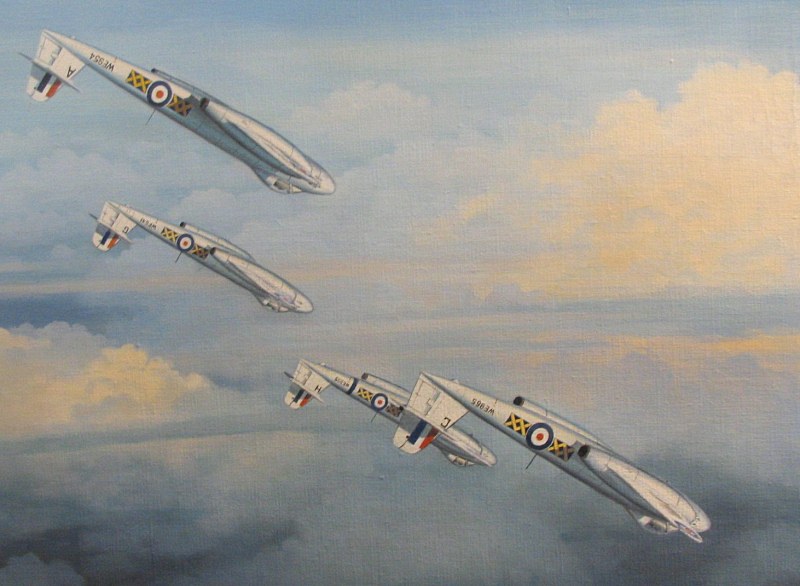
Meteor FMk 8s
photo by John Bilcliffe
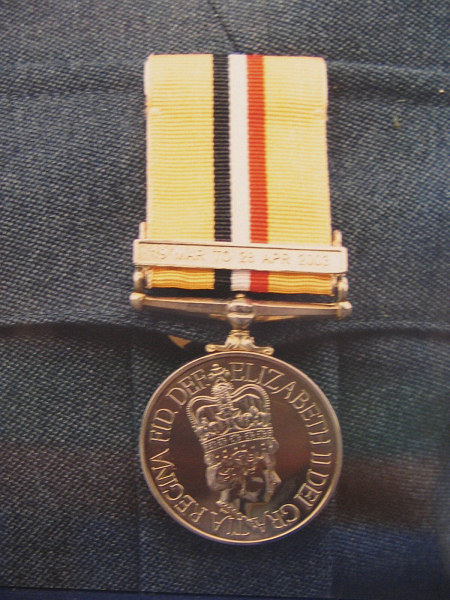
Iraq campaign medal
photo by John Bilcliffe
|
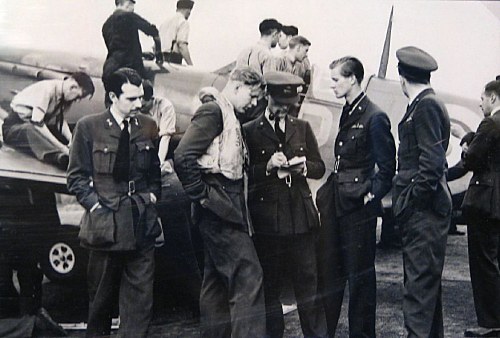
609 Sqn pilots on debrief. - photo by John Bilcliffe
|
On the 24th of February 1941 the squadron moved to Biggin Hill and took part in, 'Circus' operations over Northern France flying Mk11 and later MkV Spitfires, assisting bomber squadrons on repeated attacks on power stations, airfields and factories. Around this time, at Biggin Hill, the squadron adopted a mascot to boost morale after P/O Vicki Ortmans made friends with a goat after a drinking session at the 'Old Jail' pub near Biggin Hill. Called William De Goat he rose to be the highest ranked officer in 609 since his first commission as P/O in June 1941 ending his days as Air Commodore at Wuntsdorf in Germany returning to retire in England in a farmer's field.
In April 1942 the squadron started to receive the Typhoon 1b while at Duxford, later to become operational at the end of June. This was the first fighter to exceed 400 mph on the RAF's books and during early trials it was once considered withdrawing the aircraft due to teething problems with its performance at higher altitudes not so good due to the unreliability of the Sabre engine and it also had a poor rate of climb but its saving grace was its brilliant low flying capability. This was soon proved against the FW.190 fighter-bombers as they made hit and run raids along the south coast too fast for the Spitfires but not for the Typhoon, with the squadron shooting down four FW.190s in one week under the leadership of Sqn/Ldr R.P.Beamont in November 1942 whilst at Manston. Most of us will only be able to identify the name of Roland 'Bee'Beamont with being the chief test pilot of the lightning and TSR.2 programme but he was also a brilliant train buster as well with 25 to his credit picked up from low level sorties over France, Belgium and Holland part of his aircraft R7752 is on display at the Elvington memorial room which depicts his victories painted on a panel, Sqn/Ldr R Beaumont DSO, DFC was later shot down in 1944 over Germany becoming a POW. Sqn/Ldr Beamont joined 609 on the 29th of June as a flight commander while the squadron was based at Duxford later taking command in October leaving the squadron in may 1943.
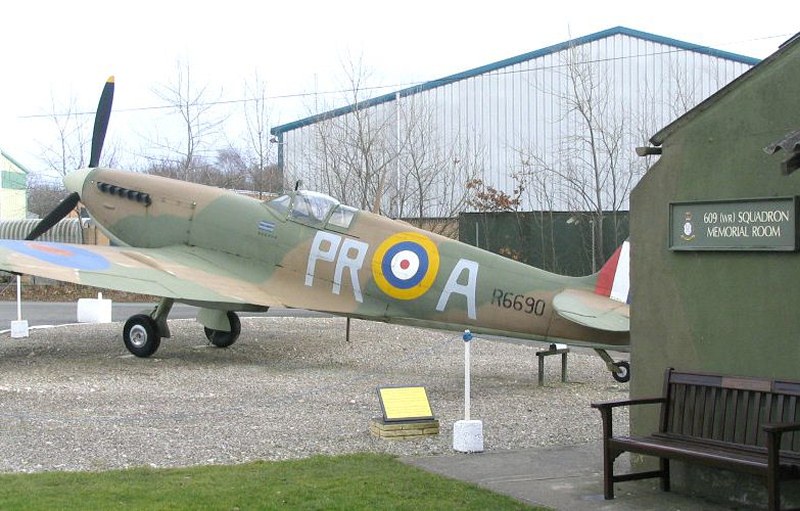
Spitfire Mk1 replica
photo by John Bilcliffe
| |
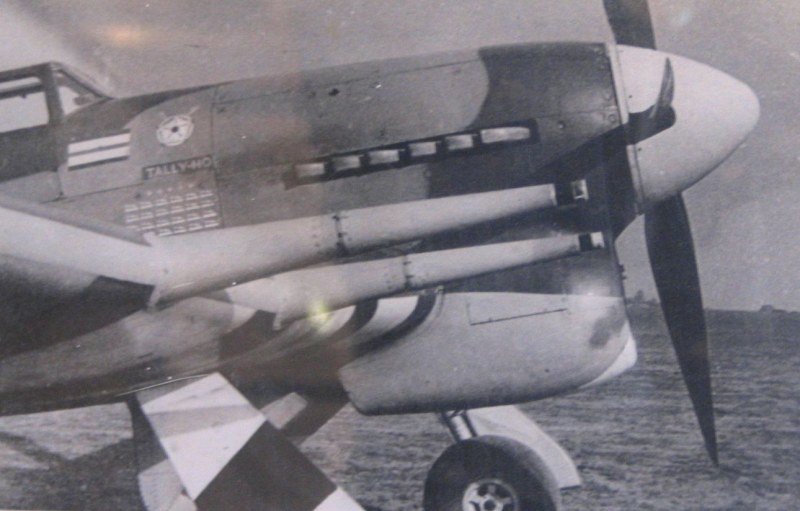
Typhoon R7752 Mk1B
photo by John Bilcliffe
|
Another famous name to grace the files of 609 was that of a Polish flyer called Janusz Zurakowski whose exploits after the war as a test pilot for Glosters is aviation history and reads like a story form the 'Boys Own' annual .The squadron was made up of personnel from as far away as a America and many from the near European countries, it was when Poland had been invaded by Germany and his own armies defeated that Janis Zurakowski already an officer in the Polish Air Force made his escape to England via Romania, Syria and France. Enlisting in the RAF as a volunteer reserve he was first posted to 234 Sqn., at St Eval Cornwall and later joining 609 on the 6th of October 1940 at Middle wallop with three claims during the Battle Of Britain, leaving 609 in march 1941. In post war years he joined the Gloster aircraft company as a test pilot where he developed a new manoeuvre called the 'Zurabatic Cartwheel' stunning crowds at Farnborough in 1951 in a ground attack version of the Meteor, most enthusiasts will identify him with the massive Avro Arrow delta aircraft which he tested for Canada.
Aside from famous individual exploits, 609 as a squadron scored another first as the first Typhoon squadron to score 50 Huns and reach 227 victories, it continued to prowl the European mainland as part of 123 Wing, finishing their days there in Wunstorf, West Germany when news of the Japanese surrender marked the squadrons own disbandment in September 1945. Cost in human terms to the squadron amounted to 53 pilots killed, 20 missing and a further 31 killed or declared missing after transferring to other squadrons. Decorations for bravery were awarded to 609 and this included 3 DSOs, 22 DFCs and bars and 4DFMs .A special memorial room has been allocated to 609 squadron at Elvington Air Museum to honor the aircrew of WW2 apart from the board displaying the roll of honor are many artifacts, models photographs and information and standing outside the hut a full size replica SpitfireMk1a R6690 that of Sqn/Ldr H S George Darley Commanding Officer 609 during the Battle of Britain. In May of 1946 the squadron reformed again at Yeadon with the Mosquito NF 30 night fighter and on the 16th December 1947, King George the sixth gave permission for the Auxiliary Air Force the use of the Royal prefix. In 1948 they were to use Spitfires again, this time the LF 16 returning changing back to a fighter squadron till it entered the jet age in 1951. Operating out of Church Fenton the Spitfires gave way to Vampires which they used for 2 months only to swap for the Meteor 4, Serving alongside 2 other full time squadrons 19 and 72 till the 11th of February 1957 till the Royal Auxiliary Air Force was disbanded.
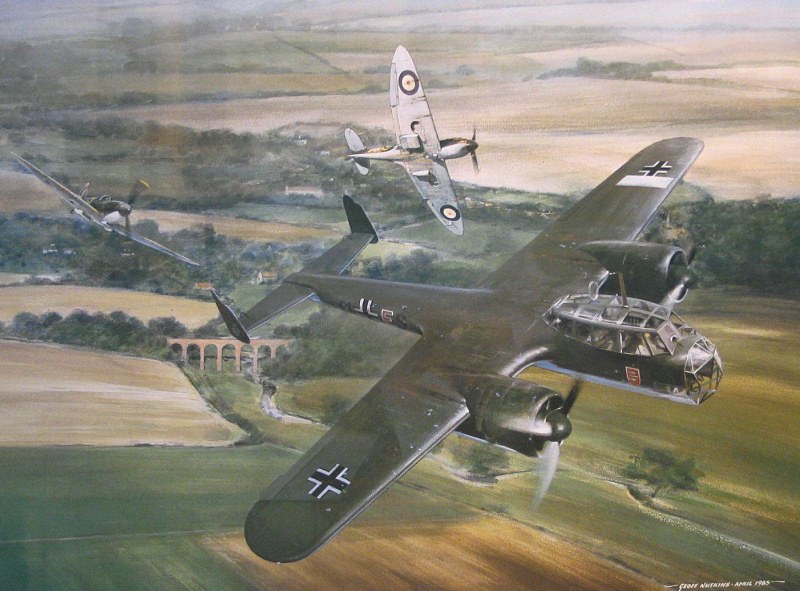
The height Of The Battle
Sunday Sept 15 1940
photo by John Bilcliffe
| |
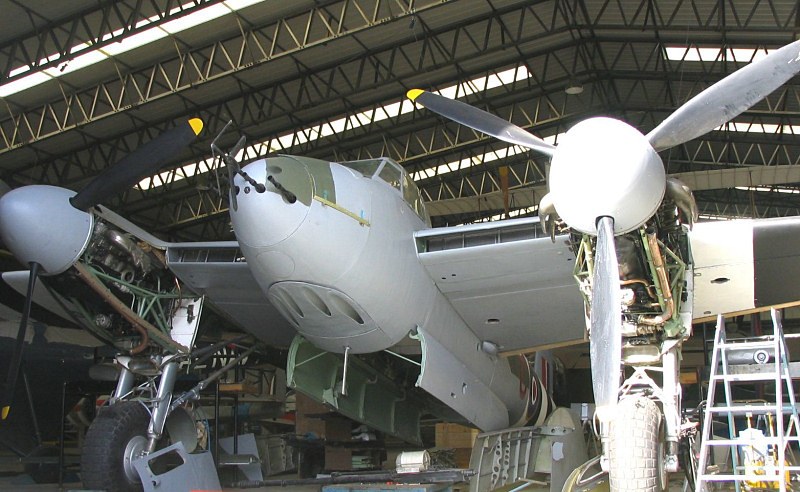
Mosquito NF11
photo by John Bilcliffe
|
The story doesn't end there as 41 years later on the 1st July 1998 the Air Defence Support Squadron was formed at RAF Leeming as one of the new Royal Auxiliary Support Squadrons in the Royal Air Force, the name itself implies what role the new squadrons have to perform and in this day of uncertain times the support squadrons are there to assist not only in war but also in times of crisis nationally and worldwide. On the 1st of October 1999 the Air Defence Support Squadron based at RAF Leeming was granted the use of the 609(West Riding) number plate, picking up a baton any volunteer would be proud to serve under.
Not to be out done by its flying counterparts of the past, the newly formed 609, have already picked up a first in having the honor of being the only formed squadron from RAF Leeming to have toured and returned in the last Gulf War conflict. Selection is made from a broader area, unlike that of the early day distance restrictions, as the new 609(WR) is the only Auxiliary Squadron in the North East of England, a 50 mile radius sweep is used to recruit locally from Leeming and provided a good road system network can be used, consideration will be given to folk living further afield and the age limit must be between 17 and 50 except for those with previous military experience it rises to 55.
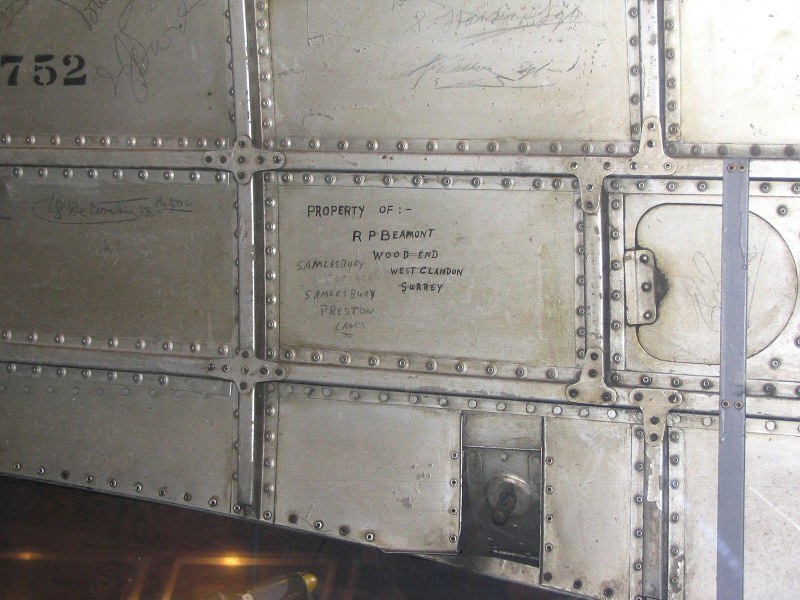
Typhoon R7752 Mk1B panel -
'property of R P Beamont'
photo by John Bilcliffe
| |
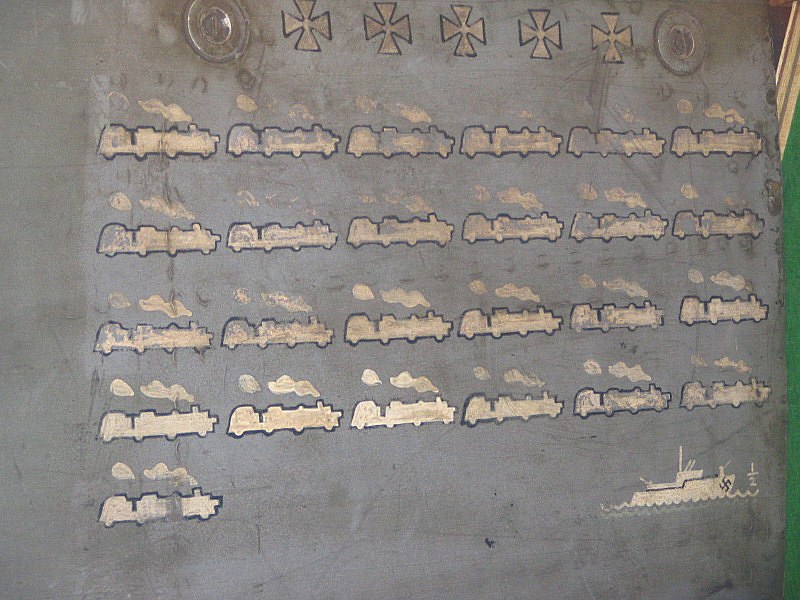
Typhoon R7752 Mk1B panel shows
the amount of trains busted
photo by John Bilcliffe
|
I have included a web site hyperlink for 609(WR) which gives more details and specifics about them. Although they are a non flying unit now, they still have some connection with the air, and that is to support the Great North Air Ambulance helicopters as best they can, organizing events to raise cash for their cause, the squadron adopted the charity for 2006. Being an officially recognized charity the 3 helicopters that cover Durham and Teeside, Cumbria and the North East do not at present have any major sponsor with the Automobile Association being the last in 2004 and as it's pointed out on 609s web site, it is crucial to act within the first hour to have any chance of making a life saving change to any person injured needing their services.
Last year (2005) Great North Air Ambulance had to ground one of their helicopters due to the fact that a lot of charity money had been diverted to other causes such as the "Tsunami" and the floods in America in New Orleans after the Hurricane. The Charity, which receives no Government, Local Authority or NHS funding, relies totally on the public for support.
The 'Great North Air Ambulance' website can be found here which gives more details and where you can make a donation to this worthy cause.
Also the squadron run first aid courses for free that last 3 hours, and have a small team called Heartstart which run this, more information can be found on 609s website about this activity, all this with pay and some foreign travel, it certainly is worth thinking about if you want something a little different to do on a part time basis. One thing I do know, I was glad to find out about 609(West Riding) Squadron as it has opened my eyes about the Royal Auxiliary Air Force and maybe had it not been for them I wouldn't have been able to write this.
Some web related sites:
www.609wrsquadron.co.uk
609(West Riding) squadron Archives
609 squadron photographs
www.greatnorthairambulance.co.uk
Books:
Under the White Rose...Frank Ziegler...ISBN 0356036413
Books...609 At War..James Douglas Earnshaw...ISBN 0954517903
To Live Among Heroes...George Armour Bell...ISBN 1902304802
Fighter Pilots Summer...Wg/cdr Paul Richey with Norman Franks...ISBN 1904010628
Fighter Boys and The battle of Britain 1940...ISBN 0142004669
Article and photos by John Bilcliffe
|
|




